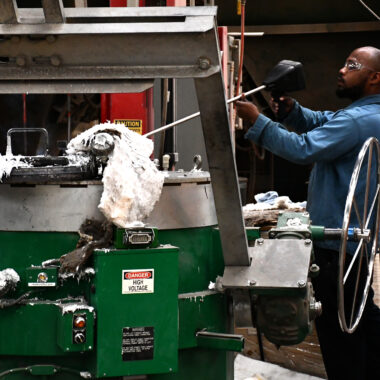Aluminum Casting Proficiency: Strategies to Elevate Your Manufacturing Process
Aluminum Casting Proficiency: Strategies to Elevate Your Manufacturing Process
Blog Article
The Top Methods for Aluminum Spreading That You Required to Know
From the typical sand spreading technique to the intricate investment casting procedure, each technique supplies unique advantages that provide to various project needs. As we navigate through the top methods for aluminum casting, it comes to be obvious that mastering these approaches is critical for accomplishing ideal results.
Sand Casting Method
The Sand Casting Method is an essential approach in aluminum casting, widely utilized for its cost-effectiveness and adaptability in creating intricate metal shapes. This technique includes developing a mold and mildew made from compressed sand into which liquified light weight aluminum is put, enabling it to strengthen and take the form of the mold. Among the crucial benefits of sand spreading is its capacity to create complicated geometries with relatively reduced tooling prices, making it an eye-catching choice for manufacturers seeking to produce special elements.
In the sand spreading procedure, a pattern of the final component is pushed into a fine sand combination included within a flask. As soon as the pattern is removed, a dental caries representing the last part's shape is left in the sand. Molten aluminum is then put into the cavity, filling up the room and taking on the specific information of the pattern. After the light weight aluminum cools and strengthens, the sand mold is broken away, exposing the recently cast aluminum part. Sand spreading is frequently used in different markets, including auto, aerospace, and art shops, because of its capability to generate both huge and little steel components with elaborate designs.

Investment Casting Process
An intricate method employed in light weight aluminum spreading is the Investment Casting Refine, known for its capacity to generate highly detailed and intricate metal elements. Additionally referred to as the lost-wax spreading process, this method goes back countless years and continues to be a popular choice in different industries as a result of its flexibility and precision - aluminum casting.
The financial investment spreading procedure begins with the development of a wax pattern, which is covered with a ceramic shell to form a mold. The wax is after that melted out, leaving a tooth cavity in the form of the preferred part. Molten light weight aluminum is put into the ceramic mold, taking and filling the dental caries on the complex information of the initial wax pattern.
This method is favored for its capability to create complicated shapes with exceptional surface finish and dimensional accuracy. It is typically used in the manufacturing of aerospace elements, fashion jewelry, and industrial machinery where detailed styles are called for. The financial investment casting procedure offers high repeatability and can create get rid of marginal machining called for, making it an economical option for many applications.
Permanent Mold Approach
Using a various technique from the Investment Casting Refine, the Permanent Mold Approach in aluminum casting provides an unique method for developing metal parts. In this approach, a recyclable mold, commonly made of steel or cast iron, is utilized to form the liquified aluminum. The mold is preheated to a specific temperature level before the aluminum is poured into it. The heat transfer from i was reading this the molten steel to the mold and mildew helps in solidifying the light weight aluminum quickly, minimizing the cooling time compared to sand casting.
One of the crucial advantages of the Permanent Mold And Mildew Method is the improved surface area coating and dimensional accuracy of the spreadings generated. This method is likewise recognized for its capability to create high-strength aluminum components with constant high quality. Additionally, the recyclable nature of the mold makes it an affordable option for medium to high quantity production runs.
Die Spreading Innovation
Making use of innovative production processes, pass away casting technology provides an extremely reliable approach for creating detailed aluminum parts. This strategy includes injecting molten aluminum into a steel mold and mildew, known as a die, at high pressures. The die is specially made to form the aluminum into the preferred type, leading to high precision and exceptional surface area finish.
Die casting offers numerous benefits. It enables for the production of complicated forms with thin walls, limited resistances, and smooth surfaces, making it excellent for applications where looks and precision are important. Furthermore, die casting allows rapid production prices, decreasing general manufacturing time and costs.

Lost Foam Spreading Method
Die casting modern technology's performance and accuracy in generating aluminum components lead the way for exploring the Lost Foam Spreading Method as a corresponding production strategy. Lost Foam Spreading, additionally known use this link as evaporative pattern spreading, is a technique that makes use of foam patterns to develop complex light weight aluminum components. This process includes developing a foam pattern that is coated with a refractory product to create a shell. The layered foam pattern is after that hidden in sand, and molten light weight aluminum is put into the mold, evaporating the foam as it moves in and takes its form.
Among the crucial benefits of Lost Foam Casting is its capability to create complex designs with intricate information that may be testing to accomplish through conventional spreading methods. Additionally, this method gets rid of the need for cores, lowers machining procedures, and enables for tighter tolerances. Lost Foam Spreading is particularly appropriate for small to medium-sized light weight aluminum components that require high accuracy and complex geometries. aluminum casting. As industries remain to require lightweight yet sturdy components, Lost Foam Spreading shows to be an important approach in review the realm of aluminum spreading.
Verdict
To conclude, recognizing the leading techniques for light weight aluminum casting is vital for achieving top quality results in the production process. Sand spreading, financial investment casting, irreversible mold, die casting, and lost foam casting are all efficient methods for producing light weight aluminum parts with various levels of intricacy. By understanding these techniques, producers can make certain that their products satisfy the desired specifications and requirements for efficiency and resilience.
From the standard sand spreading approach to the intricate investment casting process, each strategy uses unique advantages that provide to different job requirements.The Sand Casting Technique is an essential approach in light weight aluminum spreading, extensively utilized for its cost-effectiveness and convenience in developing complex steel shapes. Lost Foam Spreading, likewise understood as evaporative pattern casting, is a method that uses foam patterns to develop elaborate aluminum components. As markets continue to demand light-weight yet long lasting elements, Lost Foam Casting proves to be a valuable method in the realm of aluminum spreading.
Sand spreading, investment casting, irreversible mold and mildew, pass away spreading, and shed foam casting are all effective methods for generating light weight aluminum components with different levels of intricacy.
Report this page